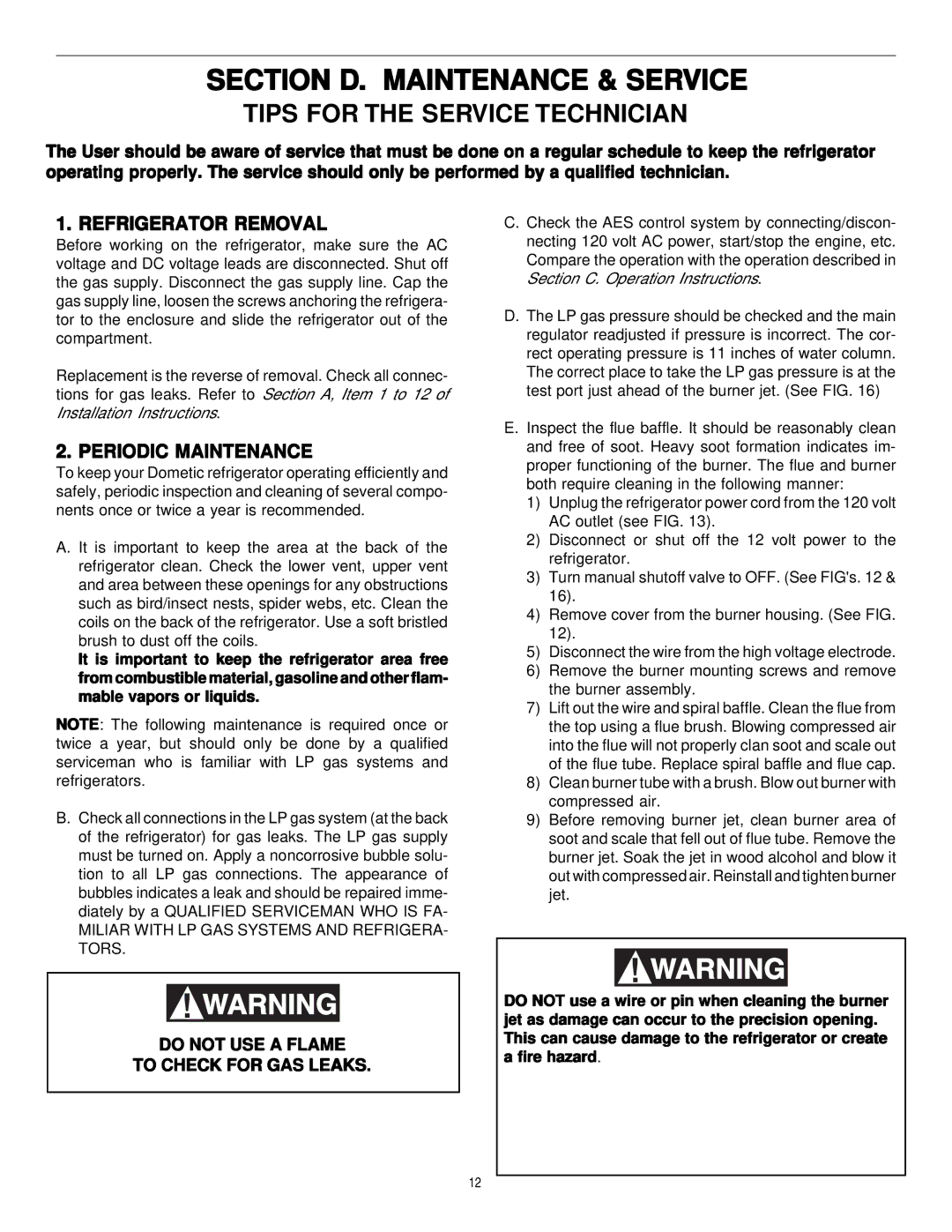
SECTION D. MAINTENANCE & SERVICE
TIPS FOR THE SERVICE TECHNICIAN
The User should be aware of service that must be done on a regular schedule to keep the refrigerator operating properly. The service should only be performed by a qualified technician.
1. REFRIGERATOR REMOVAL
Before working on the refrigerator, make sure the AC voltage and DC voltage leads are disconnected. Shut off the gas supply. Disconnect the gas supply line. Cap the gas supply line, loosen the screws anchoring the refrigera- tor to the enclosure and slide the refrigerator out of the compartment.
Replacement is the reverse of removal. Check all connec- tions for gas leaks. Refer to Section A, Item 1 to 12 of Installation Instructions.
2. PERIODIC MAINTENANCE
To keep your Dometic refrigerator operating efficiently and safely, periodic inspection and cleaning of several compo- nents once or twice a year is recommended.
A. It is important to keep the area at the back of the refrigerator clean. Check the lower vent, upper vent and area between these openings for any obstructions such as bird/insect nests, spider webs, etc. Clean the coils on the back of the refrigerator. Use a soft bristled brush to dust off the coils.
It is important to keep the refrigerator area free from combustible material, gasoline and other flam- mable vapors or liquids.
NOTE: The following maintenance is required once or twice a year, but should only be done by a qualified serviceman who is familiar with LP gas systems and refrigerators.
B.Check all connections in the LP gas system (at the back of the refrigerator) for gas leaks. The LP gas supply must be turned on. Apply a noncorrosive bubble solu- tion to all LP gas connections. The appearance of bubbles indicates a leak and should be repaired imme- diately by a QUALIFIED SERVICEMAN WHO IS FA-
MILIAR WITH LP GAS SYSTEMS AND REFRIGERA- TORS.
DO NOT USE A FLAME
TO CHECK FOR GAS LEAKS.
C.Check the AES control system by connecting/discon- necting 120 volt AC power, start/stop the engine, etc. Compare the operation with the operation described in Section C. Operation Instructions.
D.The LP gas pressure should be checked and the main regulator readjusted if pressure is incorrect. The cor- rect operating pressure is 11 inches of water column. The correct place to take the LP gas pressure is at the test port just ahead of the burner jet. (See FIG. 16)
E.Inspect the flue baffle. It should be reasonably clean and free of soot. Heavy soot formation indicates im- proper functioning of the burner. The flue and burner both require cleaning in the following manner:
1)Unplug the refrigerator power cord from the 120 volt AC outlet (see FIG. 13).
2)Disconnect or shut off the 12 volt power to the refrigerator.
3)Turn manual shutoff valve to OFF. (See FIG's. 12 & 16).
4)Remove cover from the burner housing. (See FIG. 12).
5)Disconnect the wire from the high voltage electrode.
6)Remove the burner mounting screws and remove the burner assembly.
7)Lift out the wire and spiral baffle. Clean the flue from the top using a flue brush. Blowing compressed air into the flue will not properly clan soot and scale out of the flue tube. Replace spiral baffle and flue cap.
8)Clean burner tube with a brush. Blow out burner with compressed air.
9)Before removing burner jet, clean burner area of soot and scale that fell out of flue tube. Remove the burner jet. Soak the jet in wood alcohol and blow it out with compressed air. Reinstall and tighten burner jet.
DO NOT use a wire or pin when cleaning the burner jet as damage can occur to the precision opening. This can cause damage to the refrigerator or create a fire hazard.
12
